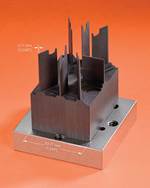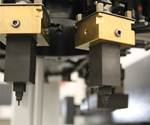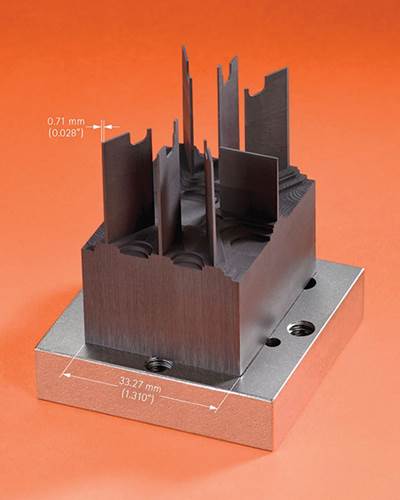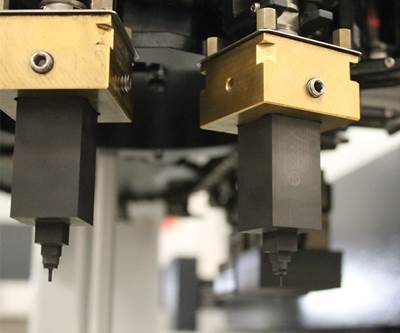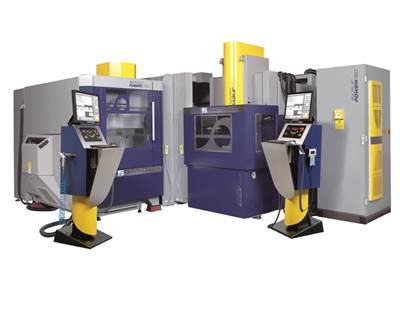Machinery Additions Accelerate Shop’s Growth
Six new Makino machines and updated processes allowed this moldmaker to penetrate new markets.
Innovation Mold and Design made a conscious decision to embrace advanced technology, hire more skilled machinists, diversify its customer base and enhance its machining capabilities. As a result, the Germantown, Wisconsin, tool, die and mold shop says it improved its mold build times, increased component quality and significantly grew its bottom line. The company says its investment in six Makino EDMs and machining centers and accompanying changes to programming and processes has been key to its accelerated growth.
Established in 1979, Innovation Mold and Design was a mature, profitable supplier of tools and mold and die components, primarily to regional manufacturers of plastic injection-molded consumer products, when Alex Hermann, a 23-year employee, purchased the shop in 2012. The company had eight to 10 customers, one of which represented about 60 percent of its revenue. Hermann quickly refocused operations to add the capabilities needed to win new business from a wider variety of customers, especially those in the automotive, aerospace and medical industries with demanding requirements for tolerances and surface finish. Today, the shop boasts 43 customers, most of which are concentrated in those three industries.
Addressing EDM First
The company initially considered buying a horizontal machining center in order to bring in house mold cavity production that had previously been outsourced. The management team wanted to use the capabilities of an HMC, including automated pallet changers and multi-sided fixturing, to expand capacity and reduce delivery times. However, during this same period of time, the team had become frustrated with a recently acquired wire EDM that was experiencing repeated mechanical issues, including frequent wire breakage and wire-threading failures, which prevented the unattended machining the company had planned. These issues briefly delayed the company’s acquisition of the HMC, as it prioritized finding an alternate wire EDM solution first.
Innovation Mold had been considering purchasing a second commodity EDM, but discussions with Single Source Techno-logies (SST), a North American distributor of Makino machines, convinced the shop that such a machine would not have met its needs for quality or capacity. Instead, the company purchased two Makino U6 wire EDMs that were installed in June 2015.
“SST showed us that there was a small difference between the original purchase price and the total cost of ownership. We chose to invest more up front in order to expand capacity and win new orders with improved quality, delivery and cost,” Hermann says. “Through reduced wire consumption, shorter cycle times, simplified maintenance and unattended operation, we were able to see a faster return on our investment while taking on additional work that we couldn’t previously accommodate.”
He says the impact was immediate due to Makino’s proprietary HyperCut technology, which is designed to simultaneously reduce cyle times and wire consumption, while eliminating the total number of machining passes necessary to achieve the required part straightness, accuracy and surface finishes. According to Lynn Bachman, SST sales engineer, HyperCut enables fine surface finishes of 3 microns Rz (16 microinches Ra) with just three machining passes (one rough, two skim cuts) using standard brass wire. Innovation Mold says it now produces more mold components while reducing consumable costs by 1.5 percent of total sales compared to the shop’s previous wire machine.
Adding In-House Capacity
In July 2015, Innovation Mold returned to its expansion plans, first purchasing a Makino a81nx HMC to bolster production of mold components, followed by investments in Makino F5 and PS95 VMCs to replace some of its aging vertical machinery. A second PS95 was purchased in October 2015.
SST collaborated with the company’s engineers and operators to revise and refine processes for each specific mold application. On the a81nx, it engineered a fully customized process, complete with tooling, workholding and programming, that matched the components Innovation Mold sought to bring in house. In addition, the HMC has a dual-pallet changer designed to make setup and loading efficient.
The company says it also maximizes the full capabilities of each machine to achieve peak efficiency. For instance, the PS95 provides a 14,000-rpm spindle that delivers 140 foot-pounds of torque, large-diameter bearings, air-oil lubrication and jacket-spindle temperature control, which together provide an ideal machine platform for extended hours of chatter-free rough cutting in mold cavities. Meanwhile, the F5 incorporates finer scale feedback, advanced thermal management technologies and Makino’s proprietary SGI.4 motion-control software to execute finer accuracies and finishes. According to Hermann, nearly all secondary machining, benchwork and fitting have been brought in house, turning what had been a source of added expenses and extended lead times into a new profit center. In 2015, 30 percent of all molds required some outsourced processes. In 2016, that number was lowered to 9 percent. In addition, the time required for secondary operations has been reduced by days, or sometimes a week or more on some projects. He says the bottom-line impact from 2015 to 2016 was that expenses for outsourcing dropped 60 percent.
The performance measurement that matters most to Innovation Mold’s leaders is reduced lead times, and bringing work in house has made that possible. Hermann says delivery of some lens mold components featuring complex bezel geometries used to take as many as 10 days due to outsourcing. By eliminating outsourcing transportation times and acquiring more advanced machinery, he says the shop is now able to produce these mold components in house in as little as two hours for some applications. The company also runs the machines unattended over nights and weekends whenever possible. As a result, some mold builds that previously spanned eight weeks can now be completed in four weeks.
Cutting More Accurately
The dependability and predictability of the Makino machines are what Innovation Mold’s production managers and operators say is most important to them. By producing feature tolerance repeatability as fine as 0.0001 inch, these machines have enabled the shop to cut handwork by 30 percent, it says. This level of precision is derived from their rigid construction and thermal management capabilities. For instance, the F5 incorporates large castings that provide a robust cutting platform, and it integrates 8-mm fine-pitch ballscrews and 0.05-micron scale feedback. Core-cooled ballscrews and spindle technologies assist in preventing vibration, enabling hours of continuous, tight-tolerance machining. Hermann says that in several applications, the machines produce perfectly even tool blends across nearly half a dozen cutters, eliminating nearly all hand-fitting of shutoffs and parting lines.
The U6 wire EDMs also have yielded tolerances that were initially surprising to Innovation Mold operators, says Mark Shaw, operations manager. In one of the first jobs produced on the machines, the shop’s quality lab reported components out of tolerance by as much as 0.0005 inch. Checking and rechecking by both Innovation Mold and SST engineers confirmed that the U6 machines produced the components properly.
“The U6 machines were cutting to within 0.0002 inch. We discovered that our vision-based coordinate measuring machine was not as precise as the Makino wire machines,” Shaw says. “We were getting the parts we needed from the wire EDMs from the first shot.” Bachman explains that this is because all the U6’s components have been merged into a single base structure to provide improved mechanical rigidity and thermal stability, which allows for highly precise positioning and stability.
The Right Combination
Central to Innovation Mold’s growth strategy is making sure its machines are optimized with the right combinations of cutters, shrink-fit toolholding, workholding, programs and processes, says Jim Paulsen, the company’s vice president. SST and Makino engineers recommended proprietary tooling and workholding solutions customized for the company’s specific applications that yielded increases in efficiency, accuracy and tool life, he says. In addition to a positive ROI on the purchase price of the six new machines, the shop says it has benefitted from reduced operating costs as well. Milling tool and EDM consumable costs have been cut from 5 percent of gross sales to 2.5 percent.
Of chief importance to Hermann is that the company has seen notable growth since purchasing the six Makinos. Sales have increased from $2 million in 2012 to a projected $6.5 million in 2016, which he attributes to increased throughput and the shop’s ability to produce molds for lighting lenses for automotive and other applications, plus aerospace and medical parts. Additionally, Innova-tion Mold has more than tripled its workforce with the addition of skilled operators, programmers and engineers.
Related Content
Maintaining a Wire EDM Machine
To achieve the ultimate capability and level of productivity from your wire EDM on a consistent, repeatable and reliable basis, regular maintenance is a required task.
Read MoreMachining Center Spindles: What You Need to Know
Why and how to research spindle technology before purchasing a machining center.
Read More6 Ways to Optimize High-Feed Milling
High-feed milling can significantly outweigh potential reliability challenges. Consider these six strategies in order to make high-feed milling successful for your business.
Read MoreRead Next
Making EDM Profitable
The workpiece material and the process parameters of a sinker EDM operation can impact productivity and profitability.
Read MoreJustifying an EDM Upgrade
Advancements in sinker EDM technology may convince you to invest in a new machine, even if your old one is working just fine.
Read MoreReal-Time Mold Production
An automated five-axis machining/EDM cell offers a cost-effective alternative to series and batch mold manufacturing.
Read More
